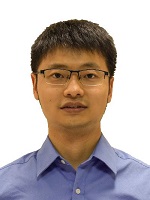
CUI Xin
Ph.D.,Associate Professor
Associate Head of Department of Architecture
Xi'an Jiaotong University
School of Human Settlements and Civil Engineering

CUI Xin
Ph.D.,Associate Professor
Associate Head of Department of Architecture
Xi'an Jiaotong University
School of Human Settlements and Civil Engineering
2017.11 – Present, Xi’an Jiaotong University, Associate Professor, Associate Head of Department of Architecture
2015.10 – 2017.10, National University of Singapore, Research Fellow
2011.08 - 2015.10,National University of Singapore, Doctor of Philosophy
2010.01 - 2010.06,Hong Kong Polytechnic University, Exchange student
2007.08 - 2011.07,Harbin Institute of Technology, Bachelor’s degree
Evaporative cooling; Renewable energy; Dehumidification; Green air-conditioning systems; Building energy analysis.
Best Paper Award, The 12th International Symposium on Heating, Ventilation and Air-conditioning (ISHVAC 2021)
Best Presenter Award, 2022 AUA Academic Conference on Sustainable Energy and Green Technology (2022)
Best Postor Award, 2nd International Conference for Global Chinese Academiaon Energy and Built Environment (2021)
Google Scholar: https://scholar.google.com/citations?user=o0C4HhQAAAAJ&hl=en
Selected Publications:
[1] Cui X, Chua KJ*, Yang WM, Ng KC, Thu K, Nguyen VT. Studying the performance of an improved dew-point evaporative design for cooling application. Applied Thermal Engineering 2014;63:624–33.
[2] Cui X, Chua KJ*, Islam MR, Yang WM. Fundamental formulation of a modified LMTD method to study indirect evaporative heat exchangers. Energy Conversion and Management 2014;88:372–81.
[3] Cui X, Chua KJ*, Yang WM. Numerical simulation of a novel energy-efficient dew-point evaporative air cooler. Applied Energy 2014;136:979–88.
[4] Cui X, Chua KJ*, Islam MR, Ng KC. Performance evaluation of an indirect pre-cooling evaporative heat exchanger operating in hot and humid climate. Energy Conversion and Management 2015;102:140–50.
[5] Cui X, Islam MR, Mohan B, Chua KJ*. Theoretical analysis of a liquid desiccant based indirect evaporative cooling system. Energy 2016;95:303–12.
[6] Cui X, Islam MR, Mohan B, Chua KJ*. Developing a performance correlation for counter-flow regenerative indirect evaporative heat exchangers with experimental validation. Applied Thermal Engineering 2016;108:774–84.
[7] Cui X, Mohan B, Islam MR, Chua KJ*. Investigating the energy performance of an air treatment incorporated cooling system for hot and humid climate. Energy and Buildings 2017;151:217–27.
[8] Cui X, Mohan B, Islam MR, Chou SK, Chua KJ*. Energy performance evaluation and application of an air treatment system for conditioning building spaces in tropics. Applied Energy 2017;204:1500–12.
[9] Cui X, Islam MR, Chua KJ*. Experimental study and energy saving potential analysis of a hybrid air treatment cooling system in tropical climates. Energy 2019;172:1016–26.
[10] Cui X, Islam MR, Chua KJ*. An experimental and analytical study of a hybrid air-conditioning system in buildings residing in tropics. Energy and Buildings 2019;201:216–26.
[11] Cui X, Yan W, Chen X, Wan Y, Chua KJ*. Parametric study of a membrane-based semi-direct evaporative cooling system. Energy and Buildings 2020;228:110439.
[12] Cui X, Yan W, Liu Y, Zhao M, Jin L*. Performance analysis of a hollow fiber membrane-based heat and mass exchanger for evaporative cooling. Applied Energy 2020;271:115238.
[13] Yan W, Cui X*, Liu Y, Tian C, Jin Oh S, Wang X, Jin L*. Performance evaluation and parameter sensitivity analysis of a membrane-based evaporative cooler with built-in baffles. Applied Thermal Engineering 2022;208:118228.
[14] Yan W, Cui X*, Meng X*, Yang C, Liu Y, An H, Jin L. Effect of random fiber distribution on the performance of counter-flow hollow fiber membrane-based direct evaporative coolers. Energy 2023;282:128881.
[15] Cui X, Yang C, Yan W, Zhang L, Wan Y, Chua KJ*. Experimental study on a moisture-conducting fiber-assisted tubular indirect evaporative cooler. Energy 2023;278:128014.